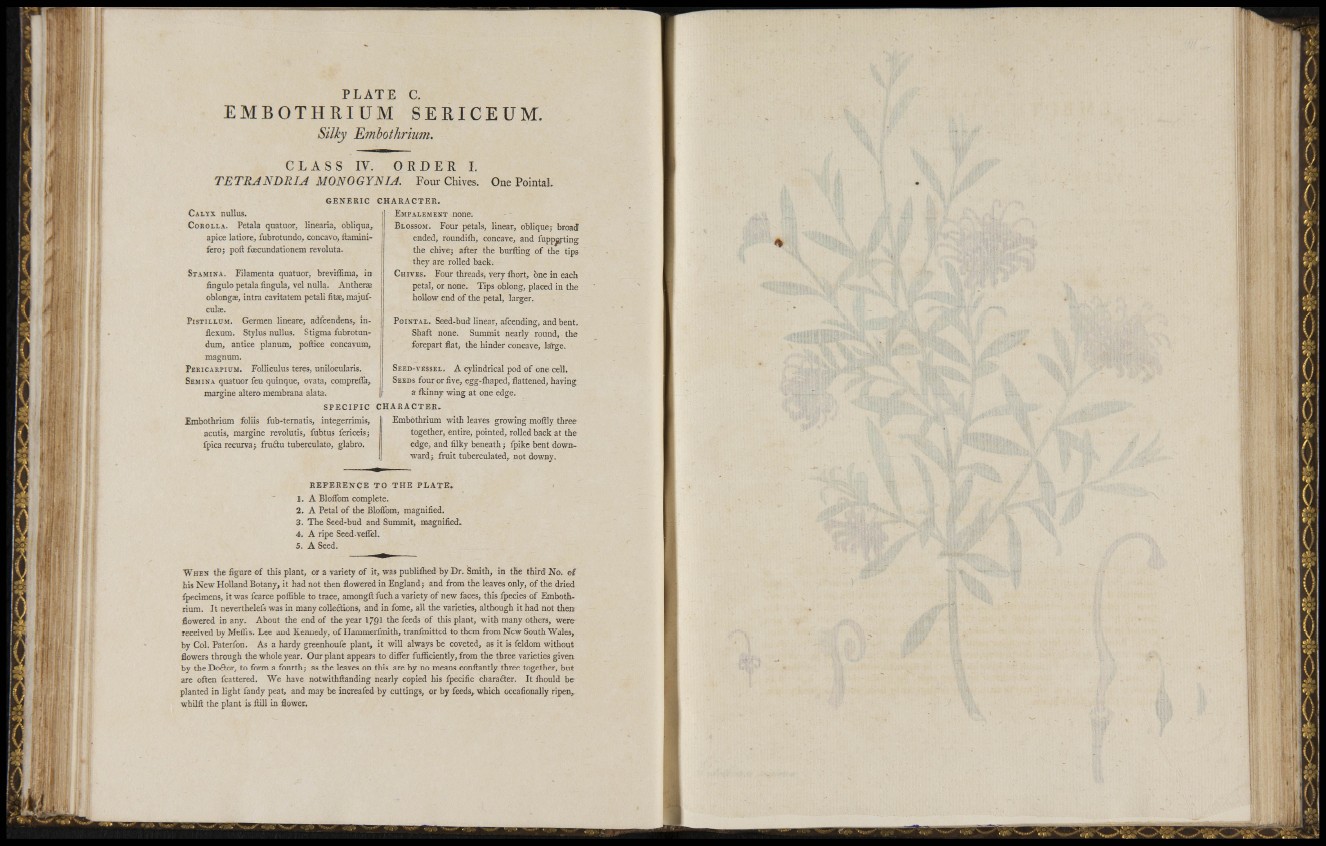
il
I '
itirÜi ' <' ^
^ i í
i ? : ? : lí
! V ' - .
P L A T E C.
EMBOTHRIUM SERICEUM.
Silky Embothrium.
C L A S S IV. ORDER I.
TETRANDRIA MONOGYNU. Four Chives. One PointaL
GENERIC
CALYX nullus.
COKOLLA. Pétala qnatuor, linearía, obliqua,
apice latiere, fubrotundo, concavo, ftarainifero;
polì foecundationem revoluta.
STAMINA. Filamenta quatuor, breviflitna, in
lingulo pétala fingula, vel nulla. Antherae
oblongae, intra cavitatem petali fitse, majufculse.
PisTiLLUM. Germen lineare, adfcendens, inflexum.
Stylus nullus. Stigma fubrotundum,
antice planum, poftice concavum,
magnum.
P E R I C A R P I U M . FoUiculus teres, unilocularis.
SEMINA quatuor feu quinqué, ovata, comprelìà,
margine altero membrana alata.
S P E C I F I C
Embothrium foliis fub-ternatis, integerrimis,
acutis, margine revolutis, fubtus fericeis;
fpica recurva) fruftu tuberculato, glabro.
CHARACTER.
]| EMPALEMENT none.
BLOSSOAM. Four petals, linear, oblique; broad
ended, roundifh, concave, and fupp^ting
the chive; after the burfting of tlie tips
they are rolled back.
CHIVES. Four threads, very fliort, one in each
petal, or none. Tips oblong, placed in the
hollow end of the petal, larger.
POINTAI.. Seed-bud linear, afcending, and bent.
Shaft none. Summit nearly round, the
forepart flat, the hinder concave, large.
SEED-VESSEL. A cylindrical pod of one cell.
SEEDS four or five, egg-lhaped, flattened, having
a ikinny wing at one edge.
CHARACTER.
1 Embothrium with leaves growing moftly three
together, entire, pointed, rolled back at the
edge, and filky beneath; fpike bent downward;
fruit tuberculated, not downy.
REFERENCE TO THE PLATE.
1. A Bloflbm complete.
2. A Petal of the Bloflbm, magnified.
3. The Seed-bud and Summit, magnified.
4. A ripe Seed-veffel.
5. A Seed.
W H E N the figure of this plant, or a variety of it, was publiihed by Dr . Smith, in the third No. of
his New Holland Botany, it had not then flowered in England; and from the leaves only, of the dried
fpecimens, it was fcarce poflible to trace, amongft fuch a variety of new faces, this fpecies of Embothrium.
It neverthelefs was in many colleftions, and in fome, all the varieties, although it had not then
flowered in any. About the end of the year 1791 the feeds of this plant, with many others, were
received by Meflrs. Lee and Kermedy, of Hammerfmith, tranfmitted to them from N ew South Wales,
by Col. Paterfon. As a hardy greenhoufe plant, it will always be coveted, as it is feldom without
flowers through the whole year. Our plant appears to differ fufficiently, from the three varieties given
by the Doftor, to form a fourth; as the leaves on this are by no means eonftantly three together, but
are often fcattered. We have notwithftanding nearly copied his fpeciflc charaQer. It fliould be
planted in light fandy peat, and may be increafed by cuttings, or by feeds, which occafionally ripen,
•whilft the plant is ilill in flower.
i m:
-
Ifi
i
' ' í
i
•"i i .t. It
r If
iJ S
if
»1/ » % •jiil' -
if ,1 !
[ > t»
• »
f r
i
ISJ- •
•i . i i'
Ht IB
M" 4 i í
•i
; •
r A ^